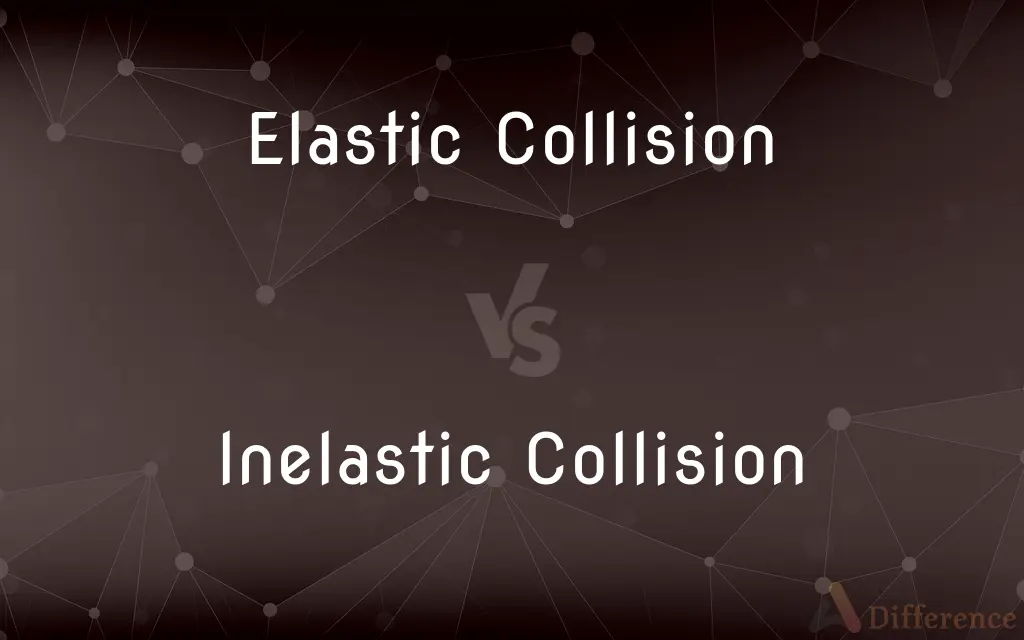Elastic Collision vs. Inelastic Collision — What's the Difference?
By Tayyaba Rehman — Published on January 22, 2024
Elastic collision involves no kinetic energy loss and objects rebound; inelastic collision involves kinetic energy loss with objects possibly sticking together.

Difference Between Elastic Collision and Inelastic Collision
Table of Contents
ADVERTISEMENT
Key Differences
In an elastic collision, two objects collide and rebound without any loss of kinetic energy and without permanent deformation. In contrast, an inelastic collision involves some loss of kinetic energy, which is transformed into other forms of energy like heat or sound.
During an elastic collision, the total kinetic energy and momentum of the system remain conserved. On the other hand, in an inelastic collision, while the momentum of the system is conserved, kinetic energy is not, leading to the objects either sticking together or deforming.
Elastic collisions are typically observed in ideal situations, like in gas molecules or billiard balls colliding where energy loss is negligible. Inelastic collisions are more common in everyday situations, like a car crash, where objects do not fully rebound and energy is dissipated.
In terms of equations, elastic collisions follow the conservation of both kinetic energy and momentum. In contrast, inelastic collisions only conserve momentum, and the calculation of final velocities requires considering the energy lost.
Real-world examples of an elastic collision include a superball bouncing off a wall, whereas a ball of clay hitting and sticking to a wall demonstrates an inelastic collision, showing the practical applications and differences of these concepts.
ADVERTISEMENT
Comparison Chart
Energy Conservation
Kinetic energy conserved
Kinetic energy not conserved
Momentum Conservation
Momentum conserved
Momentum conserved
Deformation
No permanent deformation
Permanent deformation or sticking together
Examples
Gas molecules, billiard balls
Car crashes, clay balls hitting a surface
Calculations
Kinetic energy and momentum calculations required
Only momentum calculations, energy loss considered
Compare with Definitions
Elastic Collision
In elastic collisions, both momentum and energy are conserved.
An elastic collision is demonstrated in an ideal pendulum.
Inelastic Collision
Inelastic collision conserves momentum, not kinetic energy.
When clay balls collide and stick, it's an inelastic collision.
Elastic Collision
Elastic collisions involve no permanent shape changes.
A superball bouncing off a wall undergoes an elastic collision.
Inelastic Collision
Inelastic collisions often lead to deformation or heat.
Colliding Play-Doh balls illustrate inelastic collision with deformation.
Elastic Collision
Elastic collision is where objects rebound with no kinetic energy loss.
Two billiard balls colliding and rebounding is an elastic collision.
Inelastic Collision
Inelastic collisions are common in everyday life.
A football player tackling another is an example of inelastic collision.
Elastic Collision
Elastic collision maintains total kinetic energy.
In a gas, molecules colliding elastically retain their speed.
Inelastic Collision
Inelastic collisions may result in objects sticking together.
A dart sticking to a board represents an inelastic collision.
Elastic Collision
Elastic collision assumes no energy lost to sound or heat.
Two perfectly elastic marbles colliding exhibit an elastic collision.
Inelastic Collision
Inelastic collision involves kinetic energy loss.
A car crash, where vehicles deform, is an inelastic collision.
Common Curiosities
What is conserved in an elastic collision?
Both momentum and kinetic energy.
What is an elastic collision?
A collision where no kinetic energy is lost.
Are elastic collisions common in real life?
They're less common, mostly idealized scenarios.
Can two objects stick together in an elastic collision?
No, they rebound without sticking.
What is conserved in an inelastic collision?
Only momentum.
How do physicists study elastic collisions?
Through ideal models and controlled experiments.
Is any energy transformed in an elastic collision?
No, kinetic energy is fully retained.
What is an inelastic collision?
A collision where kinetic energy is not conserved.
Are inelastic collisions common?
Yes, they're more common in everyday situations.
Are sports collisions elastic or inelastic?
Mostly inelastic, with energy loss and deformation.
What happens to kinetic energy in an inelastic collision?
It's partly converted to other forms like heat or sound.
Can objects deform in an inelastic collision?
Yes, deformation or sticking together is common.
Are there perfect elastic collisions in nature?
Perfectly elastic collisions are idealizations and rare in the real world.
Can elastic collisions generate heat?
Generally, no significant heat is generated.
Is a car crash elastic or inelastic?
It's an example of an inelastic collision.
Share Your Discovery

Previous Comparison
Pound vs. Kg
Next Comparison
Android TV vs. WebOSAuthor Spotlight
Written by
Tayyaba RehmanTayyaba Rehman is a distinguished writer, currently serving as a primary contributor to askdifference.com. As a researcher in semantics and etymology, Tayyaba's passion for the complexity of languages and their distinctions has found a perfect home on the platform. Tayyaba delves into the intricacies of language, distinguishing between commonly confused words and phrases, thereby providing clarity for readers worldwide.













































